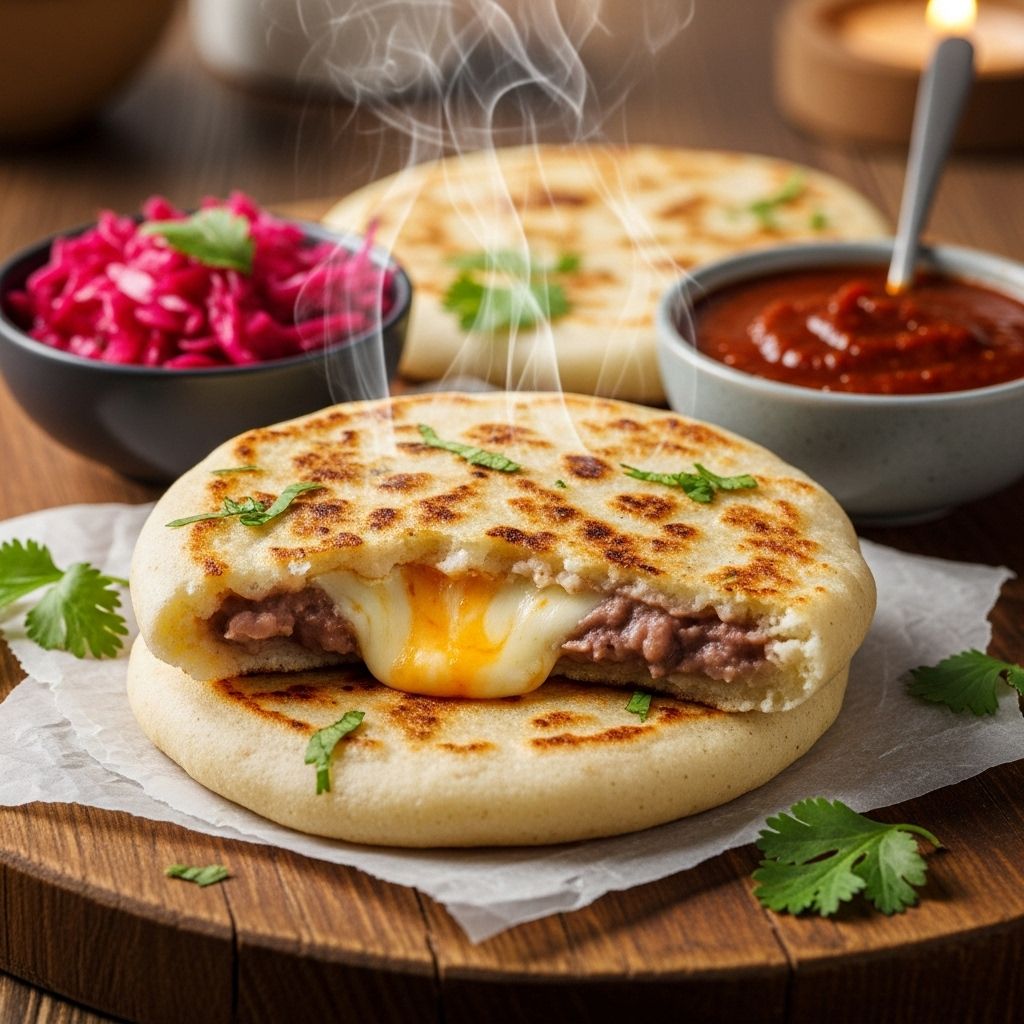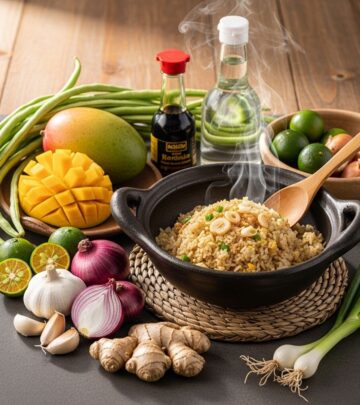Salvadoran Pupusas Recipe: 4 Easy Steps To Authentic Flavor
A heartfelt exploration of Salvadoran pupusas, their history, preparation, and the bonds they inspire in kitchens and communities.

Image: HearthJunction Design Team
Salvadoran Pupusas: Tradition, Flavor, and Family
Pupusas are more than just a dish—they are a celebration of Salvadoran culture, family, and the simple joy of home-cooked food shared across generations. From the humble kitchens of San Salvador to bustling pupuserías around the world, this national treasure is beloved for its warm, cheesy heart and rich history. In this article, we’ll delve into the origins, cultural significance, and step-by-step process for making authentic Salvadoran pupusas, as inspired by cherished family traditions.
What Are Pupusas?
Pupusas are thick, hand-formed corn cakes stuffed with a variety of fillings—most commonly cheese, refried beans, or pork—then griddled to crispy, golden perfection. They are traditionally made from masa harina, a special corn flour that brings depth and texture to the dough. Served with pickled cabbage slaw (curtido) and salsa roja, pupusas represent the soul of Salvadoran cuisine and hospitality.
The Heart of the Pupusa: Family and Heritage
At the core of every pupusa is a story. Preparing pupusas is an act of love—one that often spans generations. Many Salvadorans recall fond memories of learning the art of pupusa-making from their abuelitas (grandmothers), whose skilled hands and patient hearts pass down both recipes and family traditions. In this way, pupusas are more than food; they are a bridge between past and present, and a testament to the way food can connect us all.
Ingredients for Authentic Salvadoran Pupusas
While there are countless variations, these core ingredients will help you create classic Salvadoran pupusas at home:
- Masa harina (nixtamalized corn flour)
- Water
- Salt
- Cheese (quesillo, mozzarella, or Oaxacan cheese)
- Optional: refried beans, cooked pork (chicharrón), loroco (an edible flower), roasted vegetables
For serving:
- Curtido (pickled cabbage slaw)
- Salsa roja (Salvadoran tomato sauce)
Ingredient Notes
- Masa harina: Look for this finely ground corn flour at Latin markets or well-stocked grocery stores. The most popular brand is Maseca.
- Loroco: A traditional pupusa filling, loroco is an edible flower with a unique flavor, often found in Latin markets.
- Cheese: Mozzarella or quesillo are the most common choices for their melty, stretchy quality.
- Refried beans: Red beans mashed and seasoned, either homemade or from a can.
Step-By-Step: How to Make Pupusas
Making pupusas is a tactile, joyful process. Here’s how you can bring these flavors to your kitchen:
1. Prepare the Dough
- In a large mixing bowl, whisk together masa harina and salt.
- Gradually add water, mixing by hand until a soft, pliable dough forms. The dough should be moist but not sticky—adjust water or masa as needed.
2. Prepare the Fillings
- Shred cheese and set aside.
- If using refried beans or chicharrón, have them ready and at room temperature.
- Prepare any additional fillings, such as sautéed loroco or vegetables.
3. Shape and Fill the Pupusas
- With wet or lightly oiled hands, divide dough into golf ball-sized portions (about 2-3 tablespoons each).
- Flatten each ball into a thick disc, about 3 to 4 inches in diameter.
- Add 1 to 2 tablespoons of filling to the center.
- Carefully bring the edges up and around the filling, pinching to seal.
- Flatten gently to form a thick, filled patty.
4. Cook the Pupusas
- Heat a cast iron skillet or griddle over medium heat. Do not add oil; pupusas are cooked dry.
- Place pupusas on the hot surface. Cook for 3-5 minutes per side, or until golden brown spots appear and the dough is set.
- Serve hot, with curtido and salsa roja on the side.
Making Curtido and Salsa Roja
Pupusas are traditionally accompanied by curtido, a zesty cabbage slaw, and salsa roja, a tangy Salvadoran tomato sauce.
Curtido (Pickled Cabbage Slaw)
- Shred half a head of cabbage and grate one carrot.
- Toss with dried oregano, salt, sugar, and a splash of apple cider vinegar.
- Pour hot water over the mixture and let it marinate for at least an hour (overnight is best).
Salsa Roja (Salvadoran Tomato Sauce)
- Blend tomatoes with green bell pepper, onion, garlic, cilantro, and water.
- Simmer the mixture in a saucepan with a touch of oil, salt, and pepper until slightly thickened.
- Cool before serving.
Popular Pupusa Fillings
| Filling | Description |
|---|---|
| Quesillo/Cheese | Traditional soft Salvadoran cheese, or mozzarella for a stretchy melt. |
| Frijoles (Refried Beans) | Red beans mashed and seasoned for a creamy, hearty filling. |
| Chicharrón | Cooked and finely chopped pork, sometimes mixed with spices or sauce. |
| Loroco | Edible flower buds, offering a distinct and authentic flavor. |
| Vegetables | Roasted squash, jalapeños, or other veggies for a modern twist. |
Tips for Perfect Pupusas Every Time
- Work with moist hands. Keep a bowl of water or lightly oiled hands to make shaping the dough easier.
- Seal the edges well to prevent the filling from leaking out during cooking.
- Don’t overfill. Too much filling can cause the pupusa to break apart.
- Griddle temperature matters. Medium heat lets the dough cook through and the cheese melt inside.
- Practice makes perfect! The first few may not be perfect, but each attempt helps you learn the right touch.
Why Pupusas Are More Than a Meal
Pupusas are deeply woven into the fabric of Salvadoran life—from family gatherings to national celebrations. Every November, Salvadorans celebrate National Pupusa Day, honoring the enduring role this dish plays in their cultural identity. Making and eating pupusas is a communal act, bringing together relatives, friends, and neighbors around a shared table. They are served at home, in bustling markets, and in dedicated pupuserías.
“When you share a pupusa, you’re sharing a piece of El Salvador’s heart.”
Variations on the Classic: Exploring Pupusa Diversity
While cheese, beans, and pork are the most common fillings, Salvadoran creativity knows no bounds. Here are some ways pupusas adapt to different tastes and dietary needs:
- Rice flour pupusas: Softer and with a slightly sweet flavor, this variation uses rice dough instead of corn.
- Vegan pupusas: Fillings such as seasoned potato, sautéed greens, or plant-based cheeses provide options for all eaters.
- Fusion pupusas: Modern pupuserías offer inventive fillings like spinach and mushroom, chicken tinga, or even spicy peppers and roasted vegetables.
Frequently Asked Questions (FAQs)
What’s the difference between pupusas, arepas, and gorditas?
Pupusas are Salvadoran corn cakes filled before cooking; arepas (from Colombia and Venezuela) are cooked first and sometimes split for filling; gorditas (from Mexico) are thicker and often slit open for stuffing after griddling.
Can I make pupusas gluten-free?
Yes! Masa harina is naturally gluten-free, making pupusas a great option for those avoiding wheat.
What’s the best cheese to use for pupusas?
Quesillo (if available), mozzarella, or Oaxaca cheese all work well for their meltability and mild flavor.
How do I store and reheat pupusas?
Wrap cooled pupusas in plastic wrap and refrigerate for up to 3 days. Reheat on a dry skillet over medium heat or in the microwave until warmed through.
Can I freeze pupusas?
Yes. Place assembled (but uncooked) pupusas on a baking sheet to freeze, then transfer to a freezer bag. Cook straight from frozen, adding an extra minute per side.
The Joy of Making Pupusas Together
At the heart of every pupusa is time spent together. Whether you’re learning from an abuelita or trying your hand for the first time, making pupusas is about laughter, learning, and sharing. With a simple dough and a world of fillings, pupusas welcome everyone to the table.
So gather your family, roll up your sleeves, and let the flavors of El Salvador fill your kitchen with warmth, joy, and tradition.
Source 1: A Cozy Kitchen, Pupusas Recipe w/ Curtido and Salsa Roja
Source 2: Chili Pepper Madness, Pupusas Recipe (Salvadoran Corn Cakes)
Source 3: Food.com, Authentic Salvadorean Pupusas Recipe
References
Read full bio of Srija Burman












